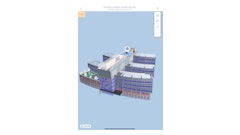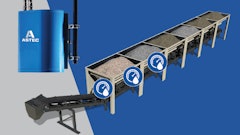
Rising inflation continues to cause major problems across our economy, and the construction industry — contractors and subcontractors in particular — have borne the brunt of higher costs and uncertainty.
Overall inflation has driven the cost of essentials sky-high, from food to fuel to office supplies and rent, kinks in the supply chain, rising construction material and the fear of a 2023 recession are stretching budgets and adding significant pressure to the construction industry.
How construction industry professionals overcome these financial hurdles may be the difference between success and failure in the year ahead.
Inflation’s Effects on the Industry
Rising labor, material, fuel, and maintenance costs weigh heavily on contractors and subcontractors. Supply chain issues driven by the pandemic and the U.S. home building boom exhausted available lumber and other key materials, and now increasing interest rates are stretching construction budgets thin.
Contractors and subtractors are grappling with high material costs, a skilled labor shortage, and continued supply chain troubles that hike up costs and set back projects. For example, steel costs soared over 200% from March 2020 to mid-2021, before finally letting up this summer. Other critical supply costs have also risen. In fact, construction material prices rose 16% from a year ago and 41% since the start of the pandemic. Although the industry has finally seen a decrease in supply chain bottlenecks, contractors and subcontractors continue to endure severe material cost challenges and uncertainty abounds.
Yet another industry hurdle is the steady escalation in fuel prices. For a subcontractor with a small fleet, filling up at $3.70 a gallon could mean over $2,000 a month in out-of-pocket fuel expenses. In California, the Pacific Northwest and parts of the eastern seaboard, fuel costs can be up to 35% higher than the national average.
Soaring diesel prices are an even greater concern for an industry reliant on heavy equipment. Earlier this year, diesel costs rose 33% in only five weeks, sending prices skyrocketing to an all-time high of $5.78 per gallon in June. According to EIA, diesel prices have jumped 141% since the pandemic began.
Paying for materials makes up about 35% to 60% of the overall construction budget. In the last three years, inflation triggered a record-breaking jump in the cost of construction projects while simultaneously creating new risk management obstacles for contractors. While the construction industry withstood the pandemic’s economic slowdown better than most industries, construction professionals still face significant hurdles.
Due to the nature of the industry, inflation impacts are particularly difficult for contractors and subcontractors. It creates cash flow management issues, longer production timelines, reduces sales volume and fuels other construction operations challenges.
On most construction projects, contractors and subcontractors must procure materials in advance and are expected to pay for those building materials within 30-60 days after purchase, long before they are paid for the job. Budget gaps will only continue to grow as those costs increase. Contractors and subcontractors lose bids and potential contracts when the cash flow necessary to float projects isn’t available.
The $1.2 trillion bipartisan infrastructure plan, considered a life raft for the construction industry, has exacerbated challenges for the industry. Having available funding for large-scale new projects is increasing demand for already scarce materials, contributing to existing inflationary pressures. Without concrete steps to help mitigate material and energy costs, prices will only continue trending upward, and contractors and subcontractors will continue to face slim margins. It’s clear to see that snowballing costs have damaging effects on the bottom line, encourage delays in construction, limit a project’s upside rate of return, and can potentially scrap projects entirely.
Construction Management Technology Eases Inflation Impacts
Unfortunately, industry experts predict inflation and uncertainty will continue to rise in 2023. In this environment, how are contractors and subcontractors supposed to secure new projects when rising costs can cause a project to become unprofitable?
First, construction professionals must focus on finding solutions for what is within their control. Thankfully, innovative, simple-to-use preconstruction technology can enhance control and productivity. These platforms improve planning, increase efficiency and help general contractors, subcontractors, and suppliers collaborate more easily to establish long-lasting connections that enhance stability and success.
Preconstruction, the crucial first phase of any project, is used to create strategic project plans, including design plans, verify vendor qualification, source materials and labor and establish communication with owners. The most effective digital tools connect all preconstruction information in one place, bringing contractors, subcontractors, and suppliers together, improving collaboration and reducing the time it takes on traditional processes.
While the construction industry is starting to prioritize the implementation of technology into its practices it remains an “old school” business reluctant to change. Nearly 40% of specialty contractors report they still primarily use spreadsheets, whiteboards, paper-based processes, or other methods instead of construction tech platforms
The right construction planning and management solutions digitize the important information and papers that contractors and subcontractors use the most. Instead of sifting through old bidding documents, spreadsheets, and random notes, software solutions provide quick and easy document replication, streamline bidding and other vital processes, and save businesses time and money.
For example, digitizing estimating and material takeoff tasks reduces the amount of time needed to complete proposals and repetitive paperwork. The increased accuracy also reduces the chances of cost overages and makes for easier cash flow. Automation and cloud-based technology also make it faster and easier for contractors and subcontractors to find new projects and provide a complete suite of tools that help you create winning bids and get there before your competition.
The technology is particularly helpful in the crucial bidding process. Easy access to documents and data helps create more detailed, accurate, and speedier bids. The right applications also notify construction professionals about new projects in their service area and can help them place their bids ahead of the competitors and gain an advantage.
Of course, effective bidding requires more than speed or low offers. Contractors and subcontractors need to build trust with project developers and showcase the attributes that make them a better fit than their competitors. Integrated construction platforms allow construction professionals to complete extensive profiles of their businesses. They can create and save data illustrating their success, such as the completion of previous projects, safety records, licenses and much more. This provides potential clients with the full scope of the company’s true value and ability.
Digital solutions can help contractors and subcontractors save money, maximize efficiencies and lessen the effects of rising inflation. By utilizing innovative construction planning and management technology now, construction professionals can improve critical business functions, strengthen collaboration, and be bettered prepared for the myriad challenges awaiting them in 2023.




























